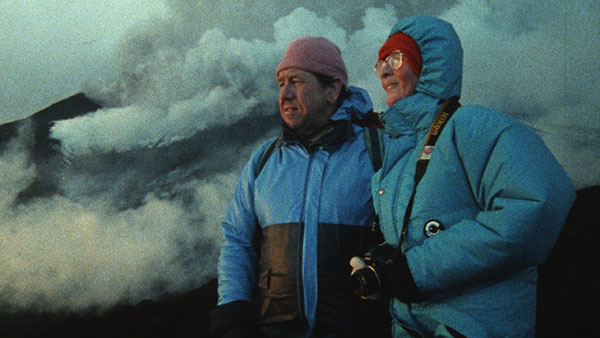Telling the story of Katia and Maurice Krafft, Fire of Love is an extraordinary documentary about love, volcanoes and the couple’s love for volcanoes.
One of the best documentaries of 2022, National Geographic’s Fire of Love tells the story of Katia and Maurice Krafft. Described as “probably the volcanologist couple in the world who have observed the most active volcanoes,” the couple spent decades analysing every volcano from Nyiragongo to Mount St. Helens. Their work culminated in 1991 when their lives (along with 41 others) were claimed by the erupting Mount Unzen in Japan. Fire of Love reveals the circumstances of the couple’s death early on, with director Sara Dosa starting the film on June 2nd, 1991. As the narration from Miranda July (Kajillionaire) explains, “tomorrow will be their last day. They will leave behind samples, words, hundreds of hours of footage, thousands of photos, and a million questions.”
In Fire of Love, the story of Katia and Maurice Krafft starts in 1966 when they first saw each other. As the film explains, it is uncertain how they first met. What is certain is that they had a lot in common. Both grew up in postwar France. Both fell in love with volcanoes at a young age. And both get into volcanology during the Plate Tectonics Revolution and the discovery of continental drift (as crucial as the discovery of the atom was to physics, according to Maurice). Soon the Kraffts begin their travels, seeking to uncover how these volcanoes behave and what makes an eruption happen. Eventually, they form a system for two kinds of volcanoes. Red ones have lava funnelling through valleys with Maurice claiming they are “no more dangerous than walking on a road in Belgium.” Grey ones are the extreme opposite – ashy, unpredictable and hazardous.
The rest of Dosa’s documentary chronicles Katia and Maurice’s shared life and career. She does this through footage taken from the couple’s archives, shot by the couple and their volcanologist colleagues. Pieced together by editors Erin Casper and Jocelyne Chaput (who are also credited as two of the film’s writers), this never-before-seen footage is captivating and stunning. You quickly find yourself marvelling at what Maurice shot, with incredible close-ups capturing lava as it contorts and twists and expands. Every eruption of a volcano shown is a thing of beauty, as we see rapid lava flows and ‘volcanic bombs,’ where stones are launched into the air.

Elsewhere, one spectacular shot places a person – presumably Katia – against a wall of fire, showing both the scale of these natural phenomena and how close the couple would get to them. Even the life-threatening grey volcanoes are somewhat picturesque, producing a gigantic mushroom cloud of smoke when they erupt. Moreover, as Fire of Love progresses, film and media become powerful tools for Katia and Maurice to remember and study volcanoes. They also highlight their differences. Katia takes still photographs of rocks and other volcanic objects to lock them in their time and place, whereas Maurice uses his camera to capture them in motion. She prefers one frame: he prefers 24 a second.
It is worth noting that Maurice’s 16mm footage was silent when Dosa started making the documentary. Therefore, the engulfing sound design was produced from scratch by Patrice LeBlanc. It contributes to a soundscape that features a score by Nicolas Godin (one-half of the French electronic duo Air) and compositions by Ennio Morricone and Brian Eno. Furthermore, I loved Miranda July’s narration. A soft and whispery voice delivering poetic and beautifully written narration, it reminds you a lot of Werner Herzog’s documentary work. An apt comparison since he made a film this year about Katia and Maurice Krafft called The Fire Within.
Fire of Love is an extraordinary documentary, brilliantly narrated and incorporating Maurice Krafft’s camerawork to wonderful effect. It can also be a sobering watch, as it contemplates how the destructive power of volcanoes costs lives – as does a woeful lack of preparation from the authorities. However, for Dosa, the stand-out element is the love story set amongst lava. Or rather, love stories. Because as Maurice summarises towards the end, Fire of Love is about the love triangle between “me, Katia and the volcanoes.” When they married in 1970, they honeymooned on a volcanic island. They decided not to have children so they could concentrate on their studies. And when they must return home to work and pay the bills, it eats at them. “When I can’t go see volcanoes, I pine for them,” says Maurice, who resorts to making homemade versions.
Dosa focuses on this sense of dual devotion – not just the devotion between Katia and Maurice but also their joint devotion to volcanology. It is the documentary’s most intriguing theme, and it helps to elevate Fire of Love, especially when it reaches its tragic yet fitting conclusion.The Kraffts were always fascinated by volcanoes. They knew the dangers they posed – the film even hints they might have been attracted to it. Either way, fuelled by a quest for knowledge, the pair helped each other fulfil their ambition to be with them. As Miranda July perfectly states midway through the film: “Alone, they could only dream of volcanoes. Together, they can reach them.”
Fire of Love is now available to watch on digital and on demand.

